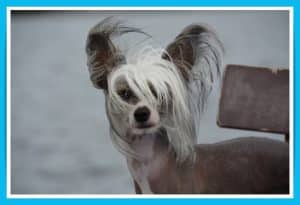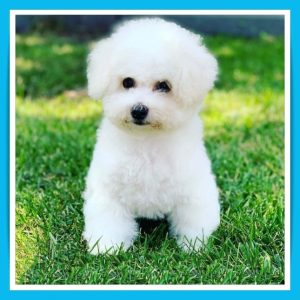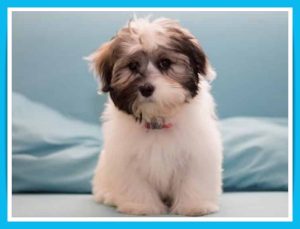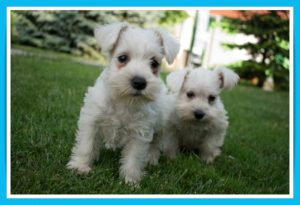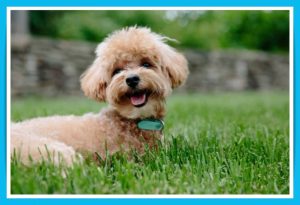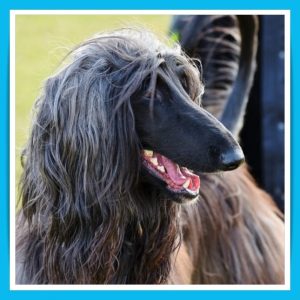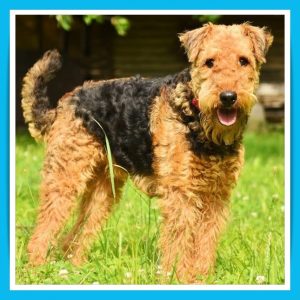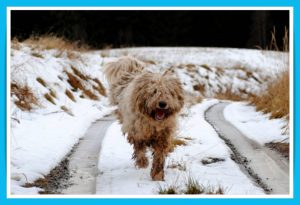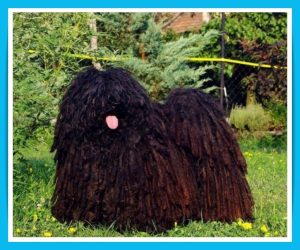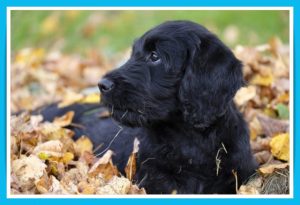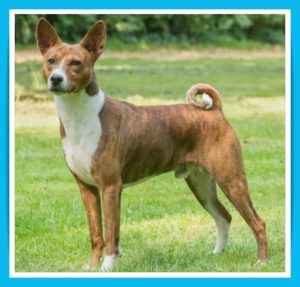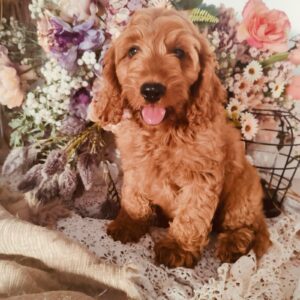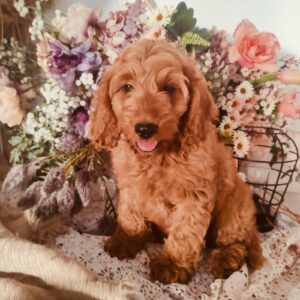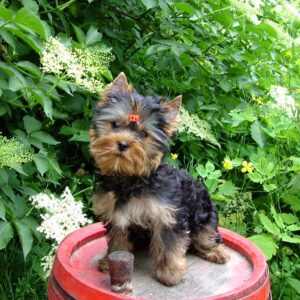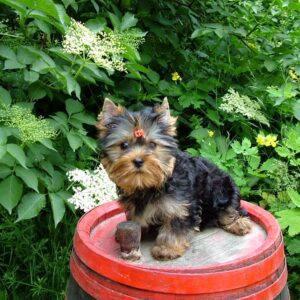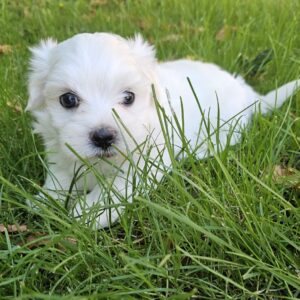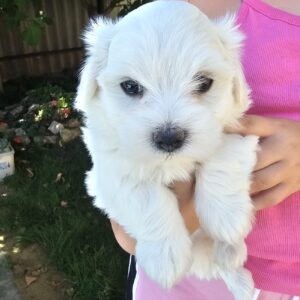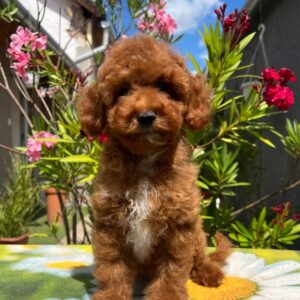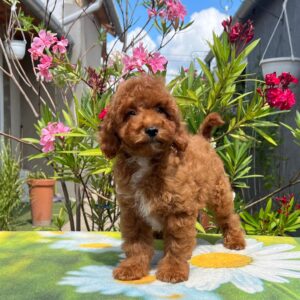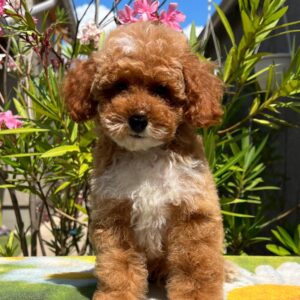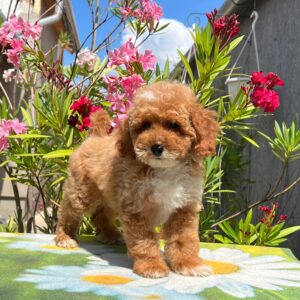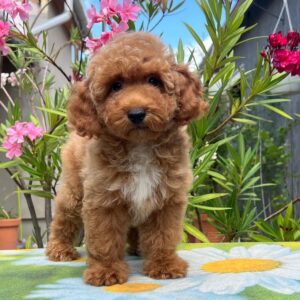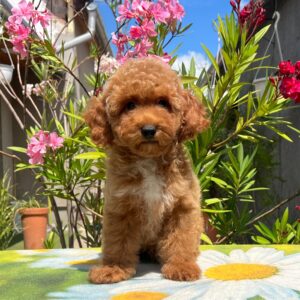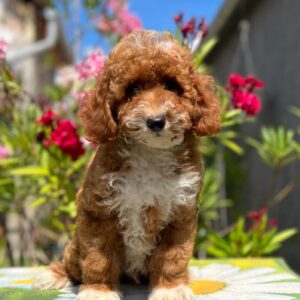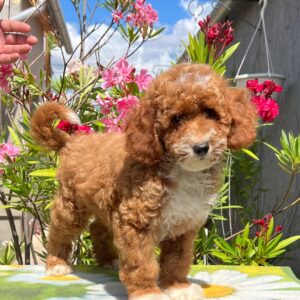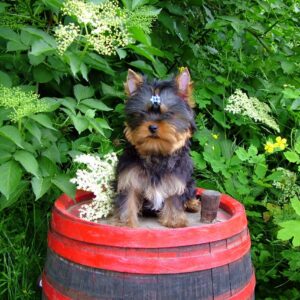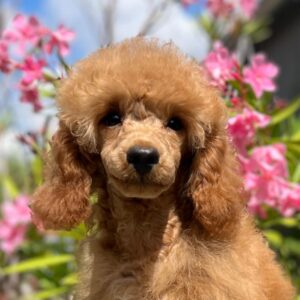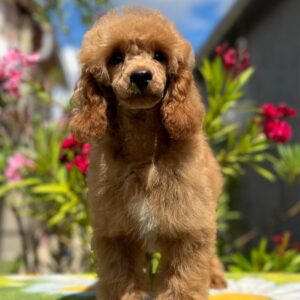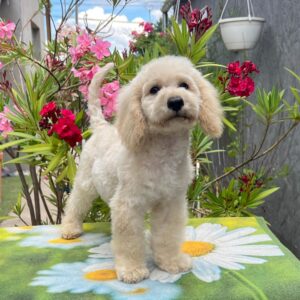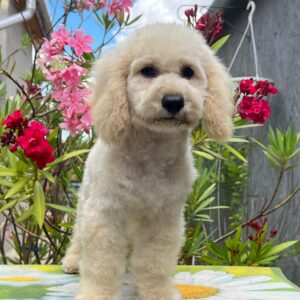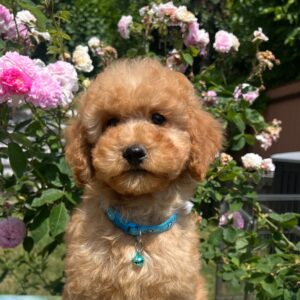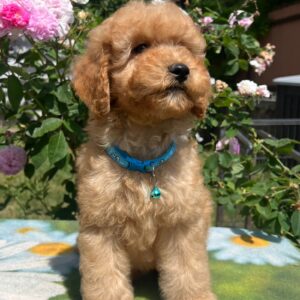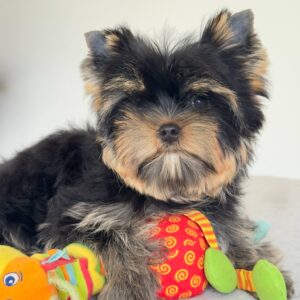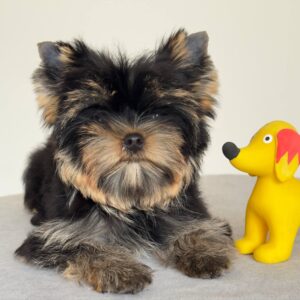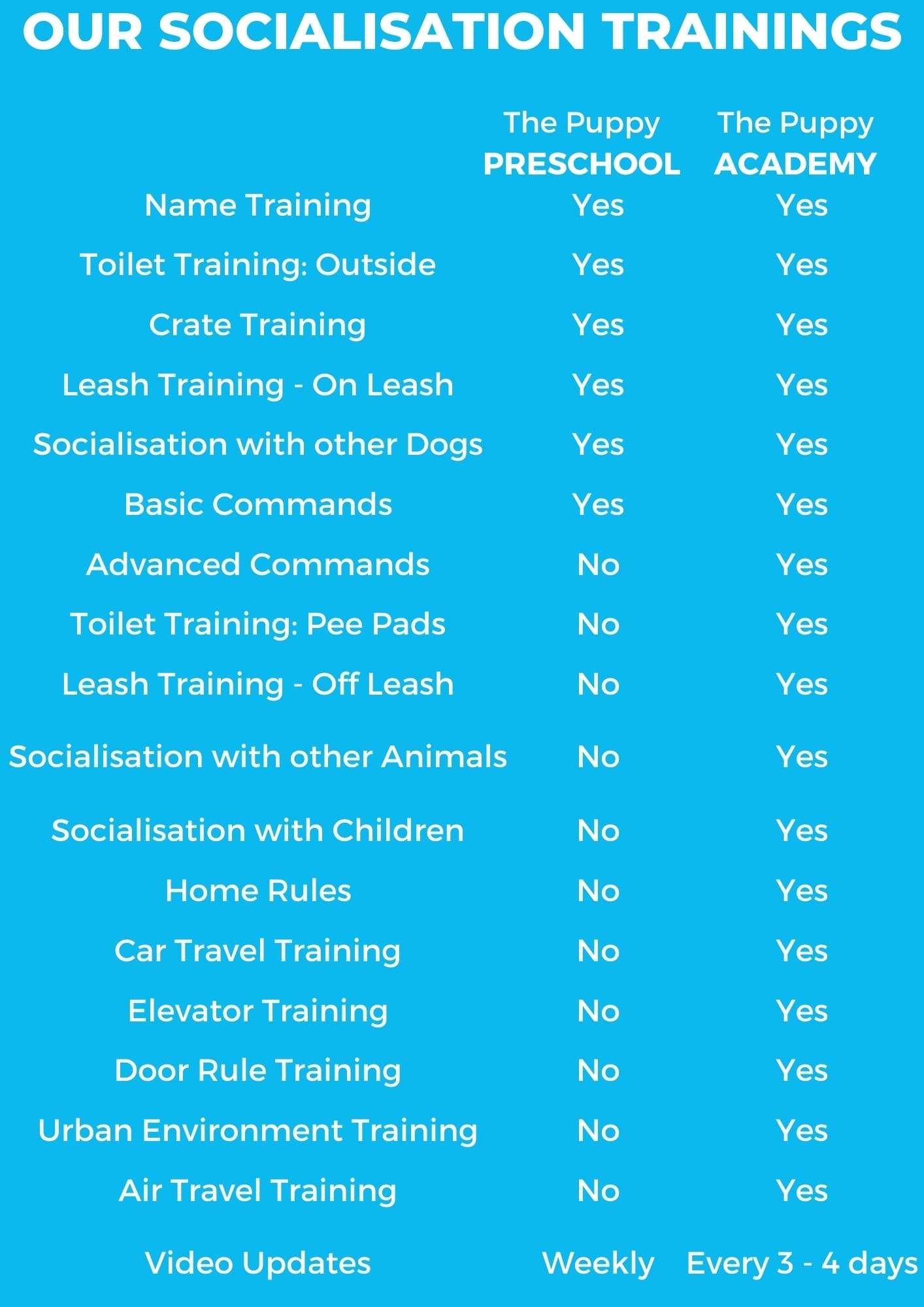HYPOALLERGENIC PUPPIES AND DOGS FOR SALE
Introduction
This article is aimed at those that would like to find a puppy for sale and own a dog, but are unfortunately allergic to them. Pet hair and dander are common allergens, typically provoking a condition called allergic rhinitis. It can be frustrating and challenging for dog lovers with this allergy that prevents them keeping or sometimes even interacting with their favourite animals. The solution is to find hypoallergenic puppies.
This section will discuss exactly what constitutes hypoallergenic puppies, which people these dogs are suitable for, and which breeds are most ideal for those with allergies.
Definitions
Allergy
The term “allergy”, according to the American Academy of Allergy, Asthma, and Immunology (AAAAI), is a chronic condition in which a person has an unusual reaction to a typically harmless substance. This reaction can be as mild as a runny nose or as severe as anaphylactic shock (which can lead to death). Pet allergies are typically not severe, with symptoms such as sneezing, wheezing, rashes, red itchy eyes, and coughing.
If you suspect that you or a family member has an allergy, it’s important to get medical confirmation to make sure that these symptoms are not being caused by another condition. Medical confirmation also means that your doctor should be able to prescribe a treatment (such as decongestants, corticosteroids or antihistamines) or other recommendations to manage the allergy.
Allergen
“Allergens” are substances that provoke allergic reactions. In the case of pet allergies, typical allergens are pet dander (tiny particles of loose skin shed by the animal), urine, and saliva (hair is not typically an allergens, but shed hair brings saliva and dander along with it). These substances contain allergenic proteins, which are responsible for triggering allergic reactions.
Hypoallergenic
The word “hypoallergenic” means a substance that provokes fewer reactions in a person suffering from allergies. In the context of this article, a hypoallergenic puppy is one that is less likely to cause an allergic reaction in someone who is allergic to dogs.
Hypoallergenic Puppies and Dogs
There is no such thing as a truly allergy-free dog breed. There are breeds and even individuals dogs that are less likely to trigger an allergic reaction; however, there is still a small chance that even these animals will trigger a reaction in certain people. These hypoallergenic dog breeds still have allergens in their saliva and dander – as much as any normal dog would have. Even hairless dogs, such as the Chinese Crested, could cause allergic symptoms because they can still shed dander, despite their lack of fur.
The good news is that even if these breed are not technically hypoallergenic dogs by scientific standards, they are still far less likely to trigger allergic reactions than other breeds. This is great news for those with dog allergies, as they can enjoy the experience of finding a hypoallergenic puppy for sale and having a dog that causes little to no health problems for them. Dog breeds with “consistent” coats are ideal because it can be easier to predict how much or how little they will shed.
How “hypoallergenic” the dog is depends on the individual dog and how severe a person’s allergy is, and how the allergy is being managed; for example, someone with a severe allergy to dog dander who is not taking any steps to treat or manage their allergy may still have allergic symptoms if they encounter even a hypoallergenic breed. Anyone with an allergy to dogs should meet several different dog breeds to see whether their allergies are triggered.
You should also research what steps you may need to take to manage your allergy, to reduce the chance of a reaction. It is perfectly possible for an allergy-sufferer to live with hypoallergenic dogs; it just takes a little extra effort.
What is the connection between non-shedding and hypoallergenic puppies?
The reason some breeds are considered hypoallergenic puppies and dogs is because they shed less frequently than normal dogs. Less hair being shed means that less dander is shed. Some of the hypoallergenic breeds, such the Maltese, are on the small side. This means that even if they shed a little dander, it’s a lot less than a larger dog would shed.
Which dogs tend to shed less? Breeds with shorter hair tend to shed less, though that’s no guarantee. Curly coats, as seen in Poodles; or wiry hair, common in terriers, are also good choices. Some dogs with longer fur, such as the Australian Silky or the Afghan Hound, shed less due to their unique silky coat.
Generally speaking, dogs with more hair-like fur are less likely to trigger an allergy because they tend to shed less. This does mean that they need more grooming, as their coats may be prone to tangling and matting. They may also need to be clipped regularly to keep their hair in check.
Managing allergies
Hopefully you’ll be able to enjoy your hypoallergenic pet’s company and have a great life together. Depending on how severe your allergy is, you may still need to take a few steps to help control any potential allergic reactions.
Cleanliness
Try to keep your bedroom and bathroom pet-free. This will reduce the build-up of dander and hair, so in these spaces you are less likely to have a reaction. You can keep your dog’s bed in a dedicated part of your home to avoid the spread of dander, and teach your dog to stay off furniture such as sofa to prevent dander spreading to these surfaces. Be sure to clean your dog’s bed, blankets, and toys frequently, and vacuum up loose hair to reduce the number of allergens around your home.
Grooming hypoallergenic puppies
Your dog will also need frequent grooming and brushing to help removed loose hair and skin flakes. Many of the breeds listed in this article need specialised grooming, but most can be brushed or bathed at home. Consult your breeder and your dog groomer for advice specific to your chosen dog’s breed. Ideally, brush or bathe your dog at least once a week. Brushing your dog outside will help reduce the build-up of dander and hair inside your home.
Going outside with hypoallergenic puppies
It’s a good idea to let your dog run around outdoors for some time each day. Your dog should certainly not live outdoors, but a few hours in the garden are fine. This is useful if you have a severe allergy. Be sure that your dog has proper food, water, and shelter outside.
Medical treatment
Finally, it’s worth asking your doctor what treatments are available. There are several options, such as drugs and immunotherapy. The latter involves injections that help to desensitise your immune system to allergens (they do not cure the allergy, but can alleviate your symptoms).
Coat Care
Many hypoallergenic dogs have coats that need special care to prevent tangles and matted hair. They tend to have coats with unique textures, and it’s a good idea to consult your groomer, breeder, and veterinarian for advice about how to best maintain your dog’s coat and skin health.
Hypoallergenic dogs like the Komondor and Puli have corded coats, with dreadlocks that need to be separated from each other and carefully cleaned from any debris every day. Dogs with curly coats, like Poodles, need daily brushing and monthly clipping. Getting a “Poodle cut” can help keep a curly-haired dog neat and tidy, and will save you a little work, but daily brushing is still important.
The semi-hairless Chinese Crested hypoallergenic dogs have exposed skin, and you may need to apply lotion to prevent dry skin, but do consult your vet and dog groomer to see what type of lotion to use and how often it should be applied. The Chinese Crested will also need a coat to wear in cold weather.
All hypoallergenic dogs need regular parasite prevention treatments. Drops can be bought from your veterinarian or pet shop, and applied to the dog’s coat at least once a month (the frequency of application and exact application method depends on the brand). Regular nail trimming, which is especially important for dogs that live primarily inside, and the occasional bath are also important to keep your dog’s coat healthy.
Hypoallergenic dog breeds
There is no official list of hypoallergenic breeds, but there is some consensus as to which dog breeds are least likely to trigger allergies. If you’re looking for a hypoallergenic puppies to add to your family, we have put together a list of 20 of the best dogs for those with allergies.
Hypoallergenic puppies come in all sorts of shapes, sizes, colours, and temperaments, so with time and research, you should be able to find the ideal dog for your family.
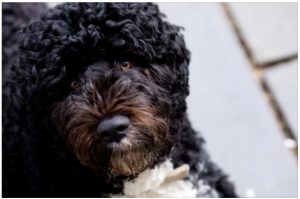
Portuguese Water-Dog: Intelligent and active, the Portuguese Water-Dog was originally bred to help fishermen with their work. This active breed has a curly coat and unique webbed feet. They shed very little, making them a great choice for people with allergies; the Obama family adopted a Portuguese Water-Dog, named Bo, for this very reason. They are medium-sized dogs and are best suited for an active person who will take time to exercise and train them. They are very clever and friendly, and get on well with children and favoured hypoallergenic puppies.
Chinese Crested: There are two coat variants for the Chinese Crested hypoallergenic puppies: the hairless, which only has hair on the head, tail, and feet; and the puffball, which has a full coat. Social and sensitive, the Crested needs proper socialisation as they tend to be nervous with strangers. They make great family dogs, though they are more suitable for older children as they are small and fragile and can get hurt by mistake in rough play. The Chinese Crested is a low to moderate shedder (even the hairless variety sheds more than you would expect), and the hairless variety can make a great pet if you have allergies. Keep in mind that they need regularly bathing and grooming to stay healthy, and while they tolerate the heat well, they do not cope well with the cold.
Coton de Tulear: Friendly, intelligent, and utterly devoted to their family. These small dogs are absolute sweethearts that make wonderful family pets. They love to play but don’t need too much exercise: a daily walk combined with playtime is enough for the Coton de Tulear. They do not shed much, but do need frequent brushing to keep their coats silky smooth.
Bichon Frise: This tiny white puffball may seem delicate, but don’t be fooled: the Bichon Frise is a tough little dog. Clever and energetic, the Bichon Frise loves company and hates to be alone. They are friendly, sensitive, and intelligent hypoallergenic dogs, capable of learning a huge variety of tricks, and even compete in sports such as canine agility. The Bichon Frise makes a great family dog, though make sure that any children know to be gentle as the Bichon Frise is sensitive and hates rough handling. The breed doesn’t shed much, but will still need proper grooming to prevent tangles.
Havanese: is incredibly friendly with everyone they meet, but they save most of their warmth and love for their family. These small dogs will stick to your side like Velcro, requesting your attention and affection. The downside is that the Havanese tends to suffer from separation anxiety, so this breed is best suited for people who work from home or can bring their dog to work. The Havanese’s silky coat is gorgeous and doesn’t shed much, but needs regular grooming. You can also opt to have it clipped.
Schnauzers come in three sizes: Miniature, Standard, and Giant. All three have a double coat, with a wiry top coat and a softer undercoat, that needs to be carefully maintained and “stripped” (a process in which loose hair is removed) at least twice a year. The good news is that all three sized Schnauzers barely shed, making them some of the best hypoallergenic puppies. Schnauzers are typically very intelligent dogs, and can be trained to master various tricks, exceeding in sports such as agility and obedience. They are friendly and playful, and are generally trustworthy with children.
The Maltese is a small, silky dog with a sweet, friendly character. This breed is a mild to moderate shedder, but if you choose to keep their coats long, you’ll need to brush them regularly. They can be a little delicate, so they are not the best choice for a home with very young children, but get on very well with older children and other pets (but do not leave them alone with small animals like hamsters, because this breed has a strong prey drive!). The Maltese is very content to live in an apartment, but although they are generally easy to train, they can be a little stubborn with toilet training at first.
Poodle: The curly haired Poodle is one of the smartest breeds out there, and can turn its paws to just about anything from hunting to circus tricks. They come in four sizes: Standard (the largest), Medium, Miniature, and Toy. All four varieties have a single-layered curly coat that is unique because instead of shedding off the dog, the loose hair and dander tangles in the surrounding hair. Although this makes them excellent dogs for someone with allergies, this can lead to a matted coat without proper care, so regular grooming is essential. The Poodle’s coat can be clipped or even corded to keep it neat and tidy. This breed is intelligent and friendly, and is a great playmate for children (the Standard is ideal, as they don’t mind a little horse play).
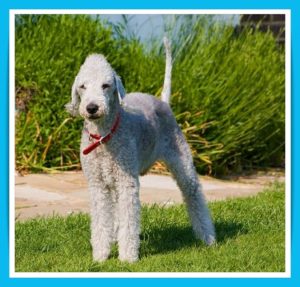
Bedlington Terrier: This friendly medium-sized breed is a great choice for first-time owners, as they are sweet and forgiving, adaptable, and very clever (though they can be stubborn at times). The Bedlington is a typical terrier and loves to play, especially if it involves pouncing on small unsuspecting animals (suffice to say, if you have a Bedlington Terrier, do not get a hamster or similar small pet!). The Bedlington is fairly active and will happily join you on walks or a game of fetch. This breed needs twice-weekly grooming to prevent tangles and mats, but fortunately their tightly curled coat does not shed much.
Afghan Hound: This stunning, slim, silky hound has beautiful long tresses. They’ll need a lot of brushing, but fortunately do not shed much, so could be considered hypoallergenic. The Afghan hound copes well with both heat and cold, and can even live quite comfortably in apartments, despite their large size. They have independent natures, and can seem aloof at times: they want affection on their terms. Don’t be fooled not thinking that these dogs are totally serious, as they have a clownish side and can be quite mischievous and playful. The Afghan hound makes a good family pet, but is much more suited to older children who will respect its sensitive nature. Be aware they these dogs have a strong prey drive, and don’t mix well with smaller pets.
Airedale Terrier: The largest of the Terrier group, the Airedale was bred to be a working dog, and as such are very energetic and hardy dogs. They are not best suited for apartment life, but with more space and plenty of exercise, make wonderful pets. They are excellent with children and other pets, very intelligent, and fairly easy to train. The Airedale only sheds moderately, and since you should be exercising them regularly, most of their loose dander should come off when they’re out and about, reduced the amount of allergens in your home.
The Hungarian Komondor is recommended only for experienced owners with plenty of space, as they are a large, self-reliant breed that, if not properly trained, may become unruly, disobedient, and overly protective. The good news is that with proper training and care, the Komondor is an intelligent and loyal dog that makes an ideal farm dog and guardian. Their unique corded coat needs proper care to keep it clean and neat, but the good news is that they only shed moderately.
Puli: This medium sized breed from Hungary resembles the Komondor, albeit smaller with a much milder temperament. The Puli is very adaptable, and is happy to live in an apartment so long as they are walked regularly. Their corded coat, likes the Komondor’s, requires proper grooming, but since they do not shed they are a great choice for someone with allergies. The Puli is wonderful with children, and is very trainable, but watch out: they have a strong herding instinct!
The Labradoodle is a Labrador Retriever and Poodle hybrid, originally bred to be a guide dog for people with allergies. While not strictly a breed by most kennel clubs, the Labradoodle remains popular both as an assistance dog and a pet. They shed minimally, and come in three different sizes: standard, medium, and mini. The texture of the Labradoodle’s coat is variable, and can be wiry, soft, curly, straight, or wavy; this means that some Labradoodles may shed, and it may be better to choose an older dog so that you know exactly how much that particular dog sheds.
Saluki: The noble Saluki is dignified as an adult, but it takes a while to get to that point because they start out as highly energetic puppies. Once they’ve grown past the destructive phase, the Saluki is a polite, athletic companion with an easy to care for coat. These gorgeous dogs are fine with children and other dogs, and only shed minimally. Salukis are not suited to living in apartments, as they need to run a few times a day. The best home for a Saluki is one where there is an enclosed yard or garden for them to run in, though you should also take your Saluki for walks every day.
Dandie Dinmont: These fuzzy little terriers have a unique quiff or poof of hair on the top of their heads. Though small in stature, the Dandie Dinmont has a big loving heart, and has become a popular family pet due to their sweet and gentle characters. These dogs only shed moderately, making them a good choice for someone with an allergy to dogs. The Dandie Dinmont only needs a walk once or twice a day, and is perfectly content to live in a smaller house or apartment.
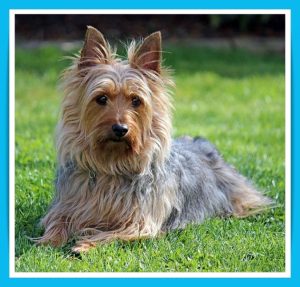
Australian Silky Terrier: Often mistaken for the Yorkshire Terrier, the Australian Silky Terrier is actually a distinct breed from the former. Active and alert, the Australian Silky Terrier is feisty but friendly, and can make a good playmate for older children who will play gently with this little dog. The Silky does not shed much, and requires surprisingly little grooming to keep its coat sleek and tangle-free.
Basenji: This African breed originated in the Congo, where they were used as hunting dogs. They are friendly to just about everyone, from kids to other dogs, and shed only occasionally. Their short coats need very little in the way of grooming, and can be kept in good condition with a little brushing and the occasional bath. The Basenji is very clever and can be stubborn; they are also well known as escape artists. Luckily all the energy and intelligence can be channelled into canine sports such as agility or lure coursing.
Bolognese: The Bolognese dog closely resembles the Bichon breeds. Originally from the city of Bologna in Northern Italy, these little dogs are highly social and make excellent pets. These fuzzy little dogs don’t shed much, but will need expert grooming occasionally. The Bolognese is highly trainable and gets along with just about everyone.
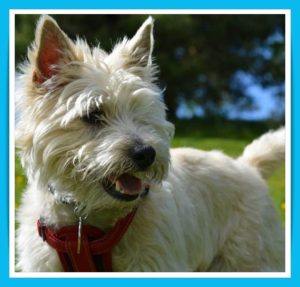
Cairn Terrier: Originally from the Isle of Skye in Scotland, this plucky little dog is a typical terrier: tenacious and tough. They adapt well to most environments, and are great with kids and other dogs. They are very easy to groom, but shed a little more than most hypoallergenic puppies’breeds.
Find hypoallergenic Puppies for Sale
Healthy, purebred hypoallergenic puppies directly from ethical breeders. Shipped worldwide with 10 year Health Guarantee.
References
The American Academy of Allergy, Asthma & Immunology. (2019). Allergy | AAAAI. [online] Available at: https://www.aaaai.org/conditions-and-treatments/conditions-dictionary/allergy [Accessed 28 Jun. 2019].
ACAAI Public Website. (2019). Pets, Dog and Cat Allergies | Symptoms & Treatment | ACAAI Public Website. [online] Available at: https://acaai.org/allergies/types/pet-allergy [Accessed 28 Jun. 2019].
Li, J. (2016). Pet allergy: Are there hypoallergenic dog breeds?. [online] Mayo Clinic. Available at: https://www.mayoclinic.org/diseases-conditions/pet-allergy/expert-answers/hypoallergenic-dog-breeds/faq-20058425 [Accessed 28 Jun. 2019].
Bassett, C. (2011). The Truth about Pet Allergies. [ebook] American Academy of Allergy, Asthma & Immunology. Available at: https://www.aaaai.org/Aaaai/media/MediaLibrary/PDF%20Documents/Libraries/EL-allergies-pets-patient.pdf [Accessed 28 Jun. 2019].
The Humane Society of the United States. (2019). How to live with allergies and pets. [online] Available at: https://www.humanesociety.org/resources/how-live-allergies-and-pets [Accessed 28 Jun. 2019].
Bakalar, N. (2011). The Myth of the Allergy-Free Dog. [Blog] The New York Times: Well. Available at: https://well.blogs.nytimes.com/2011/07/11/the-myth-of-the-allergy-free-dog [Accessed 28 Jun. 2019].
Gardner, A. (2008). First Family Will Have Tough Time Finding Hypoallergenic Dog. [online] U.S. News: Health. Available at: https://health.usnews.com/health-news/family-health/allergy-and-asthma/articles/2008/11/14/first-family-will-have-tough-time-finding [Accessed 28 Jun. 2019].

